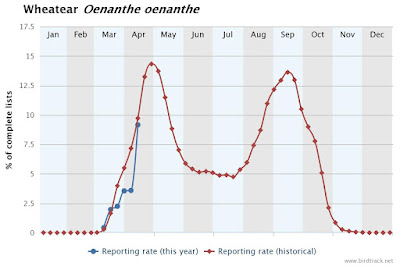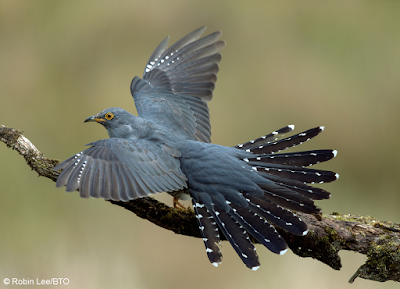Several more North American waders were found this week, as the westerly airflow – very strong at times – continued to dominate. A
Stilt Sandpiper appeared at Lodmoor RSPB, Dorset on 11 September, where it was quickly joined by a diminutive
Least Sandpiper! The same or another Least Sandpiper was retrospectively identified on the Axe estuary, Devon on 7 September, after the astute observer recognised the Lodmoor bird and scrutinised his
blurry photographs of a 'peep' that looked wrong for Little Stint but was too distant to identify in the field. The
Spurn Migration Festival (aka Migfest) got in on the act too, with this blog's regular author, Paul Stancliffe, locating an incoming
Long-billed Dowitcher...by
its call!
 |
| Spurn's Long-billed Dowitcher shortly after it touched down, by Nick Moran |
The
American Redstart that was found on the remote island of Barra in the Outer Hebrides last week hung on, proving popular with Barra regulars and long-distance twitchers alike. It's the sixth living individual of that species to reach the UK but the first for 32 years (a long-dead one was found on a tanker in late December 1993, the ship having travelled from Texas to Shetland via Angola!).
The westerly storms also brought seabirds that are trying to make their way southwards through the North Atlantic close to – and even over – the mainland. West coast based observers enjoyed a glut of
Leach’s Petrels and
Sabine’s Gulls, whilst all four species of skua have been seen from both the west and east coasts.
Great Skuas were very much in evidence on the east side of the UK on 14 September, with notable observations of 170 – including one flock of 110 – flying inland from Huttoft Bank, Lincolnshire and 62 that flew south over Foul Anchor, Cambridgeshire. These birds were presumably taking the known 'short cut' between the Wash and the Severn, though the large numbers involved were probably a result of the weather conditions.
 |
Following the movements in the last few days, the BirdTrack reporting rate for Great Skua
must surely be set to rise towards its mid September historical peak |
The storms also pushed a few
Manx Shearwater far inland, with a bird taken into care in Ely, Cambridgeshire on 14 September and another found dead in Stowmarket, Suffolk.
Meadow Pipits have begun to move in earnest with over 11,000 individuals counted moving over Spurn, East Yorkshire during Migfest. These were joined by an impressive movement of
Swallows and
House Martins over the same weekend, when around 1,500 of each were counted. A few
Swifts hang on, the BTO's own
Nunnery Lakes reserve hosting one as late as 15 September.
Pink-footed Geese started arriving in the first week of September but numbers on the move increased in the last few days. The weather seemed to displace some of these, too, with a
skein of 31 over northwest Worcestershire on 14 September being unusual so far south this early in the year.
A mid September BTO Bird Migration Blog post couldn't end without mention of a popular – and increasingly numerous – migrant,
Yellow-browed Warbler. Shetland received its first on 9 September, whilst mainland UK had to wait until 14 September, when birds were logged in Durham, East Yorkshire, Lancashire and Norfolk. Even the briefest 'window' in the weather will see
more of these spritely Phylloscopus warblers arrive.
Nick Moran




















































